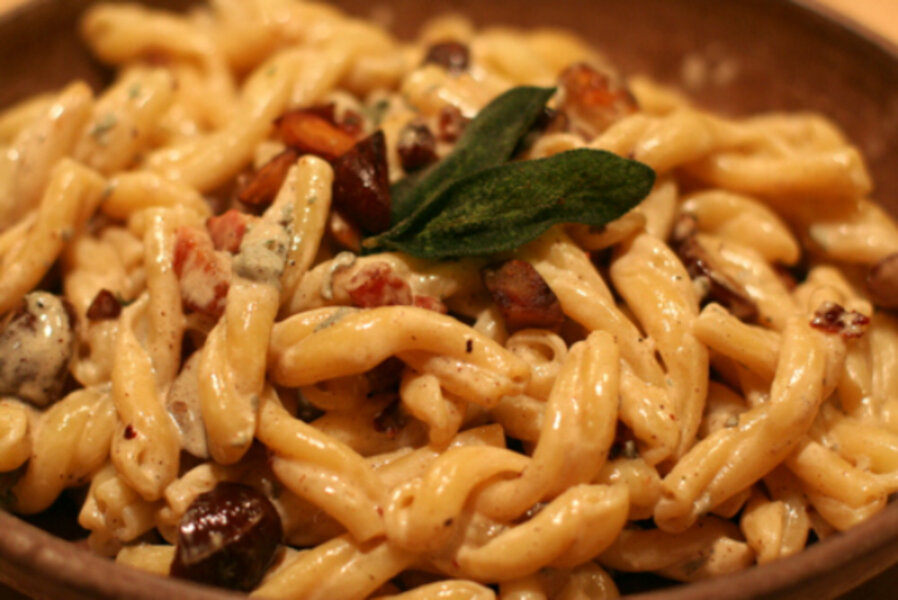Pasta with chestnuts, pancetta, and sage
This recipe was born from my love for chestnuts, and my overzealous purchase of them before Thanksgiving. I include chestnuts in my dressing, and when I see them on the shelves, I go a little nuts and always buy more than I need. So after that holiday madness dies down, I find ways to use them in other recipes. And by that point I have heard “chestnuts roasting on an open fire” on the radio at least once.
This dish doesn’t take long to prepare, but makes an elegant, unique meal break during this crazy season. Time to take breath and enjoy time together.
Chestnuts are nutty and slightly sweet and pair beautifully with woodsy sage and salty pancetta. I readily find packages of pre-diced pancetta at markets, but if you don’t, go to the deli counter and ask them to give you a couple of thick slices and dice those into bits. Thin sliced pancetta does not work as well.
I used a short, twisted pasta labeled “torcetti," but any short, thick pasta will work, like fusilli or casarecce. Orecchiette would work as well. The chunks of pancetta and chestnut get lost in long pastas. And I will admit, this is enough pasta to serve 4 people with a salad and some nice bread, but for big eaters, it may only serve 2!
Pasta with Chestnuts, Pancetta and Sage
Serves 4 (or two if you are really hungry)
10 ounces dried pasta
4 ounces diced pancetta
1 tablespoon chopped fresh sage, plus several large leaves
4 ounces roasted chestnuts, chopped
2 cloves garlic, minced
1 cup white wine [editor's note: may substitute cooking wine]
1 cup heavy cream
Salt and pepper to taste
Parmesan cheese
Cook the pasta in a large pot of salted boiling water, according to package instructions. Drain the pasta in a colander.
While the pasta is cooking, sauté the pancetta in a sauté pan, large enough to hold the pasta, over medium heat until it is cooked through and crispy. Use a slotted spoon to remove the pancetta to a plate lined with paper towels to drain. Drop a few sage leaves into the hot drippings and fry until deep green then remove to the paper towels. (This helps flavor the sauce, and the fried leaves are a wonderful garnish).
Drop the chopped chestnuts into the drippings and sauté until they are a deep tan color, smell nice and nutty and start to crisp up, about 5 minutes. Remove with the slotted spoon to the paper towels. Turn the heat off under the pan and let the drippings cool for a minute. Drop the garlic in the pan for just a minute (don’t let it burn or turn dark), then pour in the wine. Turn the heat on high and bring the wine to a boil. Sprinkle in about 3/4 of the tablespoon of the chopped sage. Cook until the wine is reduced by half and is thickened and syrupy, about 5 minutes. Add the cream, lower the heat to medium and simmer until heated through and slightly thickened.
Add the drained pasta to the sauce in the pan and toss to coat, stir in the pancetta, chestnuts and remaining chopped fresh sage. Season to taste with salt and pepper. Serve immediately, with parmesan cheese grated over the top.





